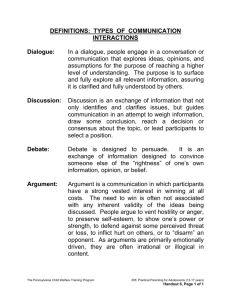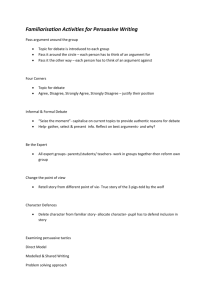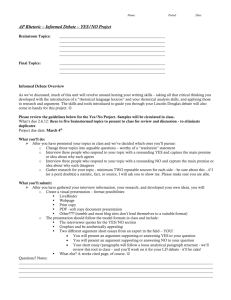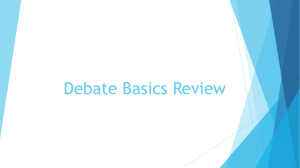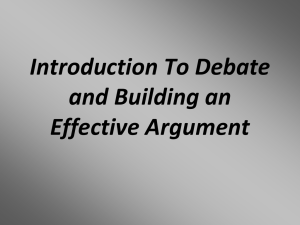Critical Thinking. - Sheffield Hallam University
advertisement
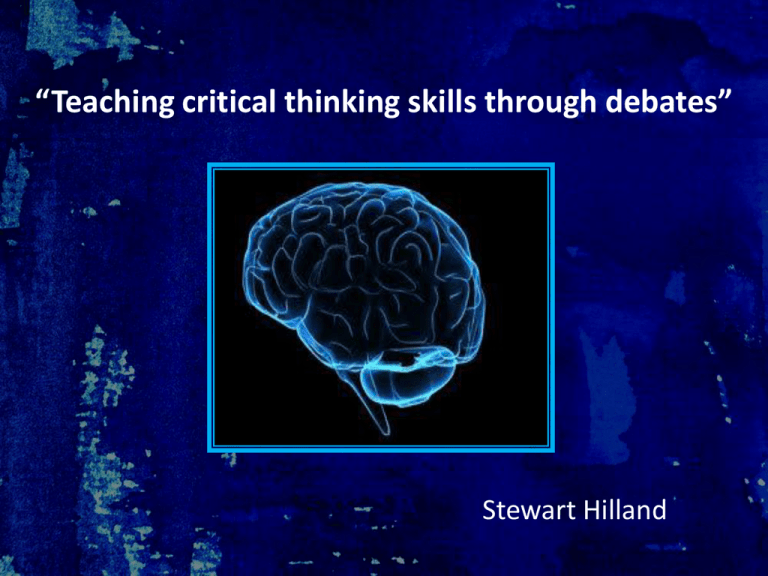
“Teaching critical thinking skills through debates” Stewart Hilland SESSION OVERVIEW Context: The module challenge Critical thinking – what, why, how? Scaffolding The debate experience Outcomes Learning Through Mega and Major Events Background on this Level 6 module… ASSESSMENT TASKS ***2010/11*** Assessment 1 : Group presentation 'An examination of what has been learned through the bidding, planning, operation and legacy stages of the 1999 Rugby World Cup or the 2002 Manchester Commonwealth Games' Assessment 2: Individual essay 'With reference to Liverpool ECoC and a range of large-scale event examples, critically assess the value and reliability of event impact studies' The group presentation assessment did not provide the necessary preparation for the challenging second assessment. How could students be encouraged to think more deeply about the topic…how could they become more critical in their thinking? CRITICAL THINKING ...what do we mean? Critical thinking can be defined as... Ennis (1996) is one of the leading writers in the field and he provides a concise, general definition of critical thinking as a reasonable reflective thinking that is focused on deciding what to believe or do. Some writers have attempted to list the skills involved: critical thinking is ‘...the intellectually disciplined process of actively and skilfully conceptualising, applying, analysing, synthesising, and/or evaluating information, gathered from or generated by, observation, experience, reflection, reasoning, or communication as a guide to belief and action.’ (Scriven and Paul, 2007 p1) CRITICAL THINKING ...why is it important in higher education? Critical thinking in higher education Coverage model (content) versus critical thinking model (Chaffe,1992) It is generally recognised that students in higher education should be taught both course content and the critical skills that will enable them to consume, process and analyse the information (at increasingly sophisticated levels) that stems from this content. Non-critical equals anti-critical ‘It is crucially important for students to be able to grasp content, be well informed in a discipline, be able to carry out necessary procedures, be engaged in learning and relate the subject matter to their own lives and future. What is misguided, however, is that we can teach for these goals effectively by using methods that do not require critical thinking.’ (Nosich, 2005 p.62) CRITICAL THINKING ...what level of CT does SHU require in teaching and learning programmes? SHU expectations... The Sheffield Hallam University Graduate Attributes... Knowledge Application Motivation and Engagement Social Responsibility Creative and Critical Thinking Sheffield Hallam graduates can think critically and creatively, and are able to formulate solutions to problems through reflection and analysis. They can grasp concepts and use knowledge imaginatively and innovatively to confront challenges and opportunities. They are able to knowledgeably critique established theories and professional practices. Integrity and Professionalism Research and Enquiry IT Capability (Digital Literacy) Communication CRITICAL THINKING ...are students expected to show critical thinking skills in EM modules? Evidence from L6 EM module assessments... Strategic Management: • 'Used and critically reviewed relevant materials from academic and industry sources ' • 'Critically and rigorously interpreted relevant data' Events Policy and Planning: • '…relevant and insightful discussion that provides an evaluative, and at times critical, examination of the legacy outcome' • Critical analysis and discussion counts for 30% of examination marks Arts Policy and Planning Managing Leisure and Sport Events: • 'Critically evaluate UK government support of Arts and Entertainments in reaching the widest audience' • 'Critically analyse and evaluate event planning models…' • 'Critical' appears in several examination questions CRITICAL THINKING ...caught or taught? Caught or taught? ‘We should be teaching students how to think. Instead we are teaching them what to think.’ (Clement, 1979 p.1) ‘...it is strange that we expect students to learn, yet seldom teach them anything about learning.’ (Norman, 1981 p.1) ‘Critical thinking is to knowing as listening is to hearing...critical thinking is a learned skill that must be developed, practiced and continually integrated into the curriculum to engage students in active learning.’ (Snyder and Snyder, 2008 p.91) ‘Critical thinking is not an innate ability. Students require training to become systematically analytical, fair and openminded in their pursuit of knowledge (Lundquist, 1999 cited in Snyder and Snyder, 2008 p.92) CRITICAL THINKING ...so how could/should it be taught? Approaches to teaching critical thinking It’s a challenge for the teacher and the students! STRATEGIES - Examples • Evaluating arguments - weighing and interpreting evidence (developing a reflective scepticism) • Making deductions • Recognising assumptions and presuppositions • Drawing inferences – deriving logical conclusions from the premises of different approaches • Imagining/exploring alternatives METHODS - Examples • Focused discussion activities • Developing questioning techniques • Problem solving • Debates • Role play • Experiential simulations • Collaborative projects DEBATES...PROS and CONS Debates...Cons Debates...Pros As presented to the 2011/12 module students (to win them over to the new assessment) Provides an opportunity for active learning that extends you individually and as a member of a team Improves research competence using wide range of media sources Will develop your reading comprehension skills…you must be sure of your data Encourages listening skills as you must listen to, process and respond to information/points made by other speakers Debates...Pros Helps you to become more critical in the way you respond to/evaluate information you read or hear Requires you to synthesise and summarise information Compels you to articulate your thoughts in a clear, precise and a logical way Helps you to construct an argument Helps you to develop skills that will contribute to success in other modules SCAFFOLDING THE TEACHING Scaffolding approach… …provides a temporary framework for learning… in which the teacher gives incremental assistance (Hogan and Pressley, 1997) 'The process by which a teacher…assists a learner, altering the learning task so the learner can solve problems or accomplish tasks that would otherwise be out of reach.' ( Reiser, 2004 p.27 ) 'Cognitive apprenticeship' (Collins et al, 1991) Dual aspects of scaffolding: providing support for learners and actively engaging the learners in the process (Hogan and Pressley, 1997)…so that the learners can think for themselves (de Grave et al, 1999) THE DEBATE EXPERIENCE Preliminaries Creating an argument Refutation Mini debate Research Team Meetings The debate THE PRELIMINARIES Familiarisation: debate terms and format The Motion Teams: Proposition Team : Sit on left of Judge They make the case for the motion Opposition Team : Sit on right of Judge They Oppose the motion 3 debaters per team and each debater speaks for 3 minutes 1st Proposition 1st Opposition 2nd Proposition 2nd Opposition Final Proposition Final Opposition ***Debaters research and prepare both Proposition and Opposition material Familiarisation: the role of each speaker (Examples) 2nd Proposition Reaffirms the Proposition team's case. Responds to (rebuts) arguments of the previous speaker (one minute) . Presents the second half of the Proposition case. 2nd Opposition Reaffirms the Opposition team's case. Responds to (rebuts) arguments of the previous speaker (one minute). Presents the second half of the Opposition case. CREATING AN ARGUMENT Arguments/How to argue ARE Assertion (the 'claim') Reasoning (the 'because' part) Evidence (the 'proof' of your reasoning) Arguments/How to argue Some assertions... The legal age for drinking alcohol should be lowered from 18 Boxing should be banned Children under the age of 16 should not be allowed to own and use mobile phones Provide some reasons and evidence to back up these assertions (Paired work) REFUTATION Refutation/How to refute Step by step refutation... They say… ...identify the particular argument made by the other team But… ...state the basics of the counter-argument Because… ...give the reasoning and evidence Therefore… ...draw a conclusion by comparing the argument and the refutation to show that the refutation is better Take a motion... ‘This team believes that boxing should be banned’ ( An outline of the Proposition arguments would follow) The first ARE The BMA has called for a ban on boxing because repeated blows to the head can cause serious injury and long-term medical problems like Parkinson's disease. Although the risk of injury in sports like rugby or horse riding is greater, the risk of serious injury in boxing is greater. A ban would mean fewer people dead, injured or permanently damaged. As the First Opposition…how would you refute this argument…and what would be the first point of your case? MINI DEBATE ‘Hosting the Olympics is a good investment’ To practise debate procedure... (Information sheet given in advance) Working in teams of 3 Proposition or Opposition Information given THE ACTUAL DEBATE Preparation... 'The 2002 Commonwealth Games was a positive investment for the city of Manchester' 'The 1999 Rugby World Cup was a positive investment for the city of Cardiff' Creating teams (3 + 3) Setting up a bank of research material Providing detailed speaker descriptions Scheduling 15 minute team consultations Blackboard Detailed speaker advice For example... 1st Opposition Reject the motion: This team rejects the motion that… Briefly outline the major arguments that will be addressed by the Opposition. Don't introduce them one by one…so do not say 'our first argument is this...', 'our second argument is that'. Weave them together…'Our case is based on (and then link them altogether)‘ Respond to (rebut) the arguments of the previous speaker (one minute) Refute by Relevance The argument lacks relevance. Perhaps the data does not 'fit' the argument Refute by Significance The argument may have some relevance but overall it is not significant (perhaps the data/size of survey is limited so it does not carry any 'weight') Refute by Capture Turn the argument to suit your case. Perhaps some of the studies used could actually work for your argument. 'They use the study by X and Y and yet this research also states that….' Refute by Answering the Argument Give evidence to dismiss the argument OUTCOMES Assessment Sheet Criteria (equal weighting) Quality and evidence of research Mastery of content (knowledge and understanding) Level of critical thinking Structure , clarity and persuasiveness of the argument Effectiveness of delivery (0) Very poor (1) Poor Weak (2) (3) Basic pass (4) Sat Effect Prof. Adv. Except. (5) (6) (7) (8) (9) (10) Video Evidence Student Feedback Preparation before the debate and taking part in the debate has... 1. Encouraged me to read about the topic from a range of sources 2. Helped me to evaluate the relevance of information 3. Helped me to break down the topic into different parts 4. Helped me to identify different elements of an argument – pros and cons 5. Challenged me to search for information to support specific debate arguments 100% Strongly Disagree 80% Disagree 60% Neither 40% Agree 20% Strongly Agree 0% S1 S2 S3 S4 S5 Student Feedback Preparation before the debate and taking part in the debate has... 6. Taught me to back up my points using evidence from sources 7. Taught me how to challenge and rebut an argument 8. Encouraged me to express my views clearly and precisely 9. In general, increased my knowledge of the debate topic 10.In general, developed my understanding of the debate topic 100% Strongly Disagree 80% Disagree 60% Neither 40% Agree 20% Strongly Agree 0% S6 S7 S8 S9 S10 Assessment 2 comparisons 'With reference to Liverpool ECoC and a range of large-scale event examples, critically assess the value and reliability of event impact studies' Percentage of cohort in each assessment band 50.00% 40.00% 30.00% 20.00% 10.00% 0.00% 2011/12 2010/11 BIBLIOGRAPHY Barnett, R. (1997) Higher Education: A Critical Business. Buckingham, The Society for Research into Higher Education and Open University Press. Braun, N. M. (2004) Critical Thinking in the Business Curriculum. Journal of Education for Business, Vol. 70 (4), pp. 232236. Chaffee, J. (1992) Teaching Critical Thinking Skills Across the Curriculum. New Directions in Community Colleges, Vol. 20 (1), pp. 25-35. Clement, J. (1979) Introduction to Research in Cognitive Process Instruction. In Lochhead, J and Clement, J. (Eds.) Cognitive Process Instruction, New Jersey, Lawrence Erlbaum Associates. Collins, A. (1991) Cognitive Apprenticeship and Instructional Technology. In Idol, L. and Jones , B. F. (Eds.) Educational Values and Cognitive Instruction: Implications for Reform. New Jersey, Lawrence Erlbaum Associates. de Grave, W. S., Dolmans, D. H. M. and Van der Vleuten, C. P. M. (1999) Profiles of Effective Tutors in Problem Based Learning: Scaffolding Student Learning. Medical Education, Vol. 33, pp. 901-906. Ennis, R. H. (1996) Critical Thinking. New Jersey, Prentice Hall. Hogan , K. and Pressley, M. (1997) Scaffolding Student Learning: Instructional Approaches and Issues. Cambridge MA, Brookline. Halpern, D. F. (1999) Teaching for Critical Thinking: Helping College Students Develop the Skills and Dispositions of a Critical Thinker. New Directions For Teaching and Learning, Vol. 80 pp 69-74. Hannon, S., McBride, H. and Burns, B. (2004) Developing Creative and Critical Thinking Abilities in Business Graduates: The Value of Experiential learning Techniques. Industry and Higher Education, Vol. 18 (2), pp. 95-100. Jonassen, D. H. and Bosung, K. (2010) Arguing to Learn and Learning to Argue: Design Justifications and Guidelines. Education Tech Research Dev, Vol. 58 pp. 439-457. Leicester, M. (2010) Teaching Critical Thinking Skills. London, Continuum Books. Lundquist, R. (1999) Critical thinking and the art of making good mistakes. Teaching in Higher Education, Vol. 4 (4), pp.523-530. McEwen, B.C. (1994) Teaching Critical Thinking Skills in Business Education. Journal of Education for Business, Vol. 70 (2) pp.99-105. Middle School Public Debate Program (2012) Teachers' Guide [Internet]. Available from: http://www.middleschooldebate.com/resources/resourcesmain.htm [Accessed 10 May 2012]. BIBLIOGRAPHY Mingers, J. (2000)What is it to be critical? Management Learning, Vol. 31 (2) pp. 219-237. Norman, D. A. (Ed.) (1981) Perspectives on Cognitive Science. New Jersey, Erlbaum. Nosich, G. M. (2005) Problems with two standard models for teaching critical thinking. New Directions For Community Colleges, Vol. 130 pp. 59-67. Omelicheva, M. Y. and Avdeyeva, O. (2008) Teaching with Lecture or Debate? Testing the Effectiveness of Traditional Versus Active Learning Methods of Instruction. Political Science and Politics, Vol. 41 (3), pp. 603-607. Randolph, D. S. (2007) Student Perceptions of the use of Debate as a Teaching Strategy in the Allied Health Professions. Journal of Allied Health, Vol . 36 (1), pp. e13-e29. Reiser, B. J. (2004) Scaffolding Complex Learning: The Mechanisms of Structuring and Problematising Student Work. The Journal of Learning Sciences, Vol. 13 (3), pp.273-304. Roy, A. and Macchiette, B. (2005) Debating the issues: A Tool for Augmenting Critical Thinking Skills of Marketing Students. Journal of Marketing Education, Vol. 27 (3), pp. 264-276. Scriven, M. and Paul, R. (2007) Defining Critical Thinking. The Critical Thinking Community: Foundation for Critical Thinking (in Snyder and Snyder, 2008). Snyder, L.G. and Snyder, M.J. (2008) Teaching Critical Thinking and Problem Solving Skills. The Delta Pi Epsilon Journal, Vol.L (2) pp. 90-99. Tempelaar, D.T. (2006) the Role of Metacognition in Business Education. Industry and Higher Education, Vol. 20 (5), pp. 291-297. Tumposky, N. R. (2004) The Debate Debate. The Clearing House: A Journal of Educational Strategies, Issues and Ideas, Vol. 78 (2), pp. 52-56.
